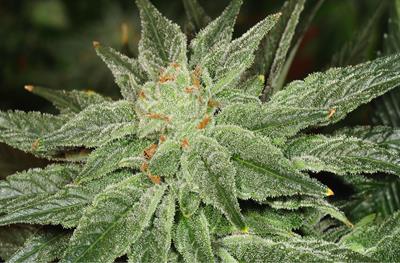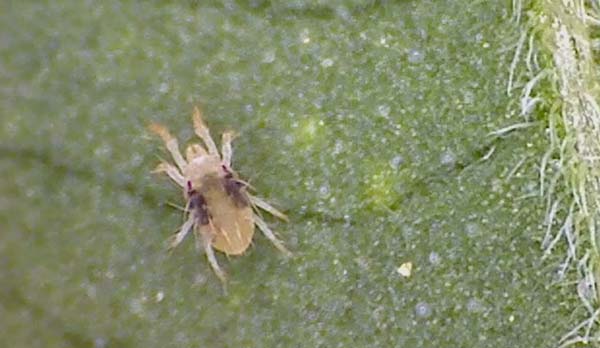
Thursday December 2, 2021
 Growing
Growing
Growing cannabis both indoors, but especially outdoors, will carry the same challenges as other gardens, particularly pests. Just as the vegetable gardener must do battle with foes like stink bugs and squash beetles, so too must the cannabis grower be on the lookout for hungry bugs that will infest, or even destroy, your plants.
The most organic form of pest control is companion planting — the practice of cultivating other, beneficial plants alongside your cannabis plant. Usually these include fragrant plants like basil and garlic, which repel many pests with their strong odor. However, when that doesn’t work, you’ll need to know where else to turn, and in a hurry.
In this article we review the most common cannabis pests, how to identify them, and how to prevent or get rid of them.
Spider Mites

Identifying Spider Mites
The most obvious clue you’ve got spider mites are the light, silky webs they spin on or between leaves, especially when mating. Spider mites generally live on the underside of plants where it is dry and shaded. They are very small, only about 1mm long, so it’s easy to miss them if you don’t look closely. They feed by puncturing plant cells to feast on the nutritious liquid inside, including chlorophyll, and will often leave behind yellow spots where the plant has been drained. These irregular spots will also be an alarming clue.
Problems Caused by Spider Mites
Plants need chlorophyll to grow, so an excessive amount of spider mites munching on chlorophyll can cause significant damage and eventually death to a cannabis plant. Not only that, but their webs are very sticky and difficult to remove, which could result in an impure harvest and a non-usable product.
How to Get Rid of/Prevent Spider Mites
When growing indoors, it’s best to avoid spider mites at all, if possible This can be done by ensuring completely sanitary conditions in your grow room including sanitary soil and supplies, air supply and of course sanitizing yourself before you get to work. Always wash hands and clothing (or wear a protective suit) before entering an indoor grow area and never allow pets access to the room.
If spider mites are already an issue, one option is to blast them off with a high-powered hose, though it’s best not to do this during the flowering stage. Neem oil is the next easiest solution. Neem oil is an organic bio-pesticide that has been deemed safe for use on vegetables and other flowering plants. Remember to repeat the cleaning process over the next few days to kill off both mites and eggs. To fight fire with fire, you could introduce a predatory mite like phytoseiulus mites, which prey on spider mites.
Aphids

Identifying Aphids
Aphids are tiny, yellow winged insects that also set up shop on the underside cannabis leaves. They reproduce quickly, with females giving live birth as often as 12 times per day, so infestations can happen quickly and should be addressed immediately. Because they consume nutrients within cannabis, the resulting leaves will appear yellow and wilted. Their feces is a glossy secretion that will present like shiny freckles on leaves.
Problems Caused by Aphids
Aphids not only consume the nutrients from cannabis plants, but their feces is a sugar-rich secretion that attracts ants. Some ants, called “dairying ants,” actually cultivate colonies of aphids to harvest this nutritious byproduct. So letting aphids hang around will attract even more pests. They have also been known to introduce viruses from near-by plants which may stunt growth or slow the production of flowers.
How to Get Rid of/Prevent Aphids
Though Mother Nature can help keep an aphid infestation in check with beneficial pests like ladybugs or parasitic wasps, you can help speed the process with the use of garlic or tomato leaf water. To make the solution, simply soak tomato leaves or garlic and mineral oil in water for 12 – 24 hours, strain the mixture then apply to one small area of the plant. If the leaves yellow after application, dilute the solution and try again.
Fungus Gnats
Identifying Fungus Gnats
Fungus gnats resemble tiny flies and are found in or flying around the soil where, true to their name, they feed on the fungus living in the grow medium. They are only 3-5mm in size and produce larvae with a dark head and transparent body. Females lay eggs within the first few inches of moist soil and larva can commonly be found in water run-off.
Problems Caused by Fungus Gnats
Fungus gnats will leave your leaves alone, but by feeding on the fungus in the soil, they will reach your plant’s roots and leave damage there. Adult cannabis plants that are otherwise healthy may be strong enough to withstand a few fungus gnats, making them more of a nuisance than an emergency, but if the plant is young, or already struggling with other factors, fungus gnats can become a real problem. They may also introduce pythium, a disease quite harmful to sensitive seedlings.
How to Get Rid of/Prevent Fungus Gnats
Fungus gnats need moist soil to reproduce, so the best way to prevent fungus gnat infestation is to keep the top layer of soil as dry as possible. Depending on your setup, this could be as simple as watering less frequently, or waiting for all the previous water to dry out before adding more (as opposed to watering a little everyday). Fly paper is another common solution, just remember to keep it low near the soil, rather than hanging it high among the leaves. Indoor grows can usually prevent fungus gnats by keeping a sanitary room and keeping windows shut or properly sealed.
Additional Pest Control Measures
Neem oil is a common, all-purpose organic pesticide that is suitable for cannabis and vegetables. While it can be toxic if ingested directly, especially by children, much of the horticultural community agrees it is not toxic when used on plants during the growing process. Neem oil has previously been suggested as the cause for Cannabinoid Hyperemesis Syndrome, which induces abdominal pain and vomiting, but in recent years those claims have not held up to scrutiny.
If you are still wary of neem oil, insecticidal soaps are another option, though they will also harm beneficial insects.

Beneficial pests like ladybugs and predatory nematodes are another good organic solution. These bugs feast on other bugs, eggs, and larvae, and will at least slow the spread of harmful infestations, making them more manageable to eradicate, if not prevent them altogether.
After all of the time, money and effort that goes into growing cannabis grow, it would be a shame to watch the harvest wither and die at the hands of pesky garden pests. Stop critters from overtaking your pot plants with these simple tips for cannabis pest prevention.
Frequently Asked Questions
What kind of bugs get on cannabis plants?
Aphids, spider mites, and fungus gnats are the most common pests across indoor and outdoor grow ops. But outdoors, cannabis can also attract caterpillars, grasshoppers, stink bugs, and thrips, among others.
Combat these pests by using organic pesticides like neem oil or pesticidal soap, or by introducing predatory insects like ladybugs and mantises to fight on your behalf.
What bugs are attracted to hemp plants?
The bugs attracted to cannabis are often the same bugs attracted to any lush, green plants. Aphids, spider mites, and fungus gnats are among the most common, but a variety of garden pests like leaf miners, mealy bugs, slugs and snails will also want to eat from a healthy cannabis plant.
What’s the easiest way to get rid of pests in my cannabis plant?
The simplest solution is often a neem oil or pesticidal soap spray. If you don’t want to use any additional chemicals on your plant, a hard spray with a garden hose will blast several pests off your leaves, but be sure your plant is strong enough to withstand the pressure. Failing that, predatory pests can be introduced to feast on the eggs and larva of other bugs—sometimes even eating the bugs themselves.
Do you have advice about controlling pests in a marijuana grow? Share it with us below.








